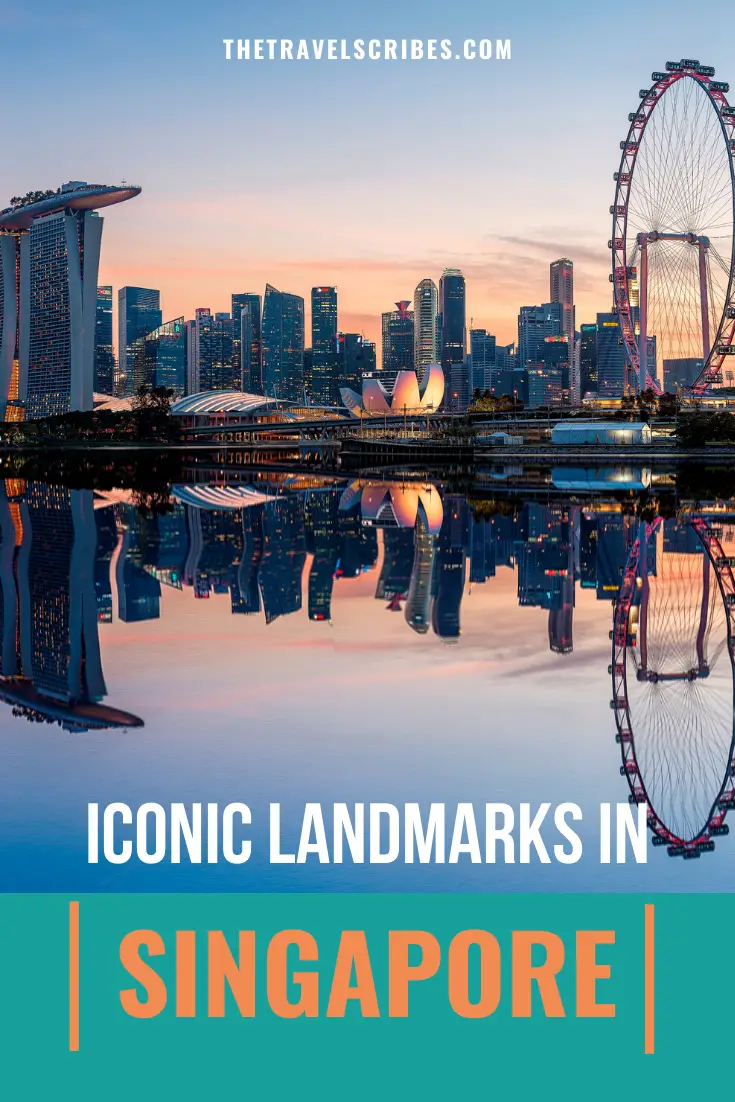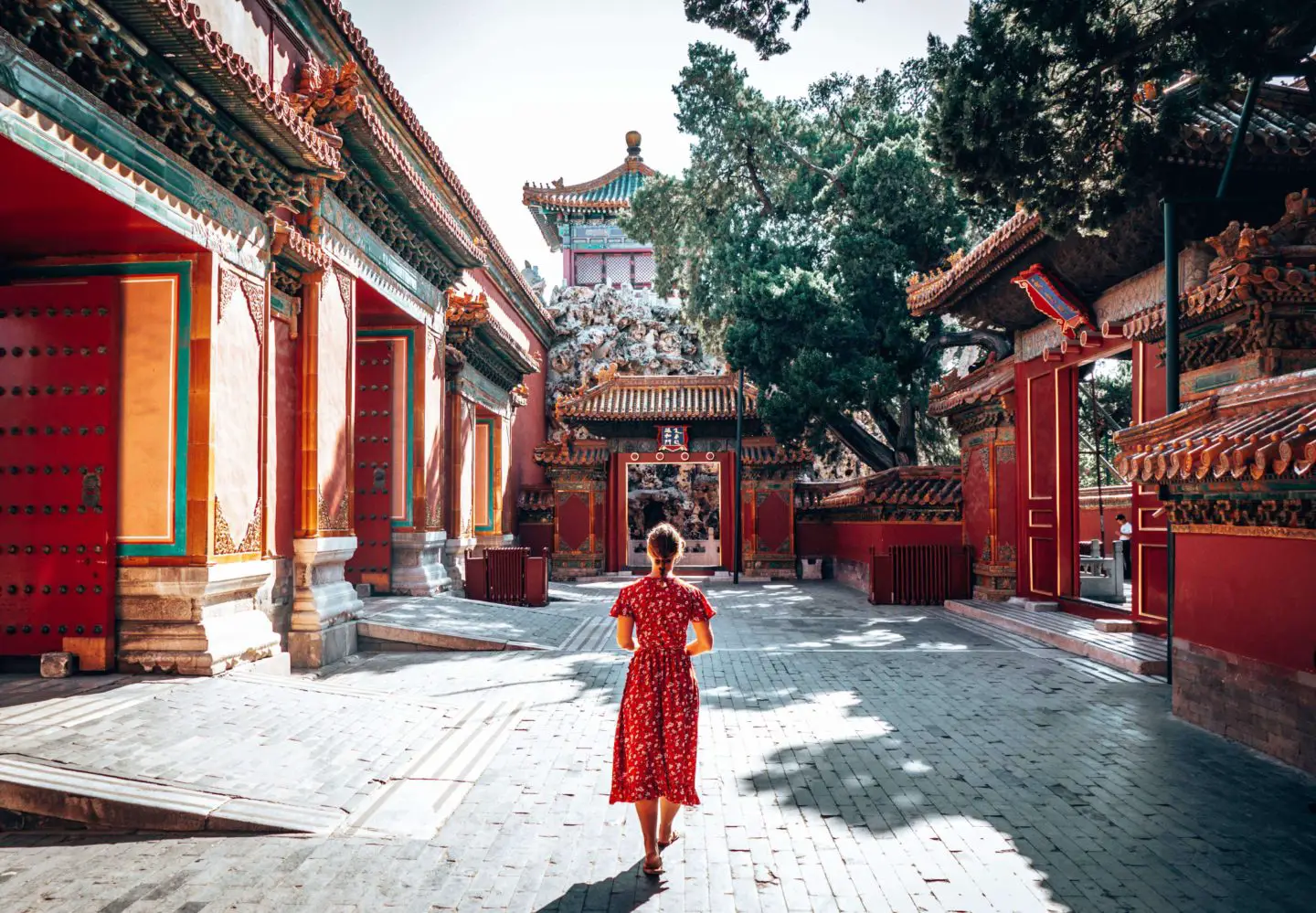The tiny island nation of Singapore is an absolute must-visit place on any Southeast Asia itinerary – from hopping between hawker stalls to doing a round of the many iconic buildings dotting its world-famous skyline. To help us count down the best of those legendary Singapore landmarks, we’ve asked a whole host of travel writers to tell us which ones you just can’t miss; our ultimate list of the best landmarks in Singapore!
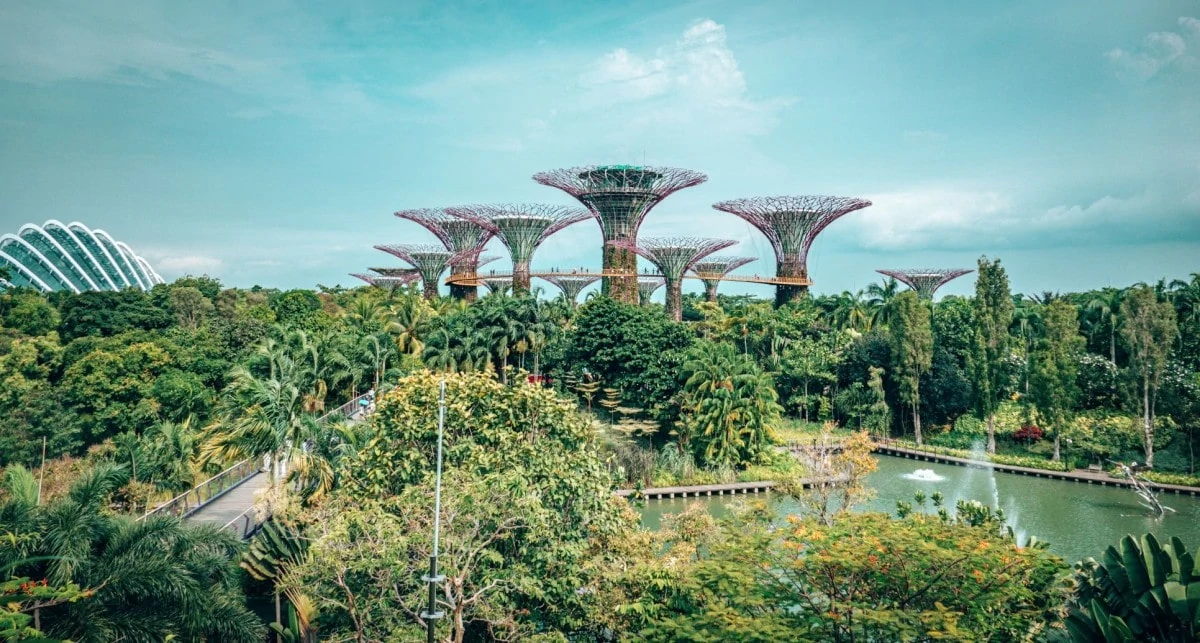
Skip ahead
Our top 10 landmarks in Singapore
- Changi Airport & The Jewel
- Gardens by the Bay & Supertree Grove
- The Merlion
- Raffles Hotel
- Sri Mariamman Temple
- Marina Bay Sands
- The Helix Bridge
- Singapore Flyer
- Joo Chiat Shophouses
- The ArtScience Museum
Changi Airport & The Jewel
Explored by Clemens from Travellers Archive
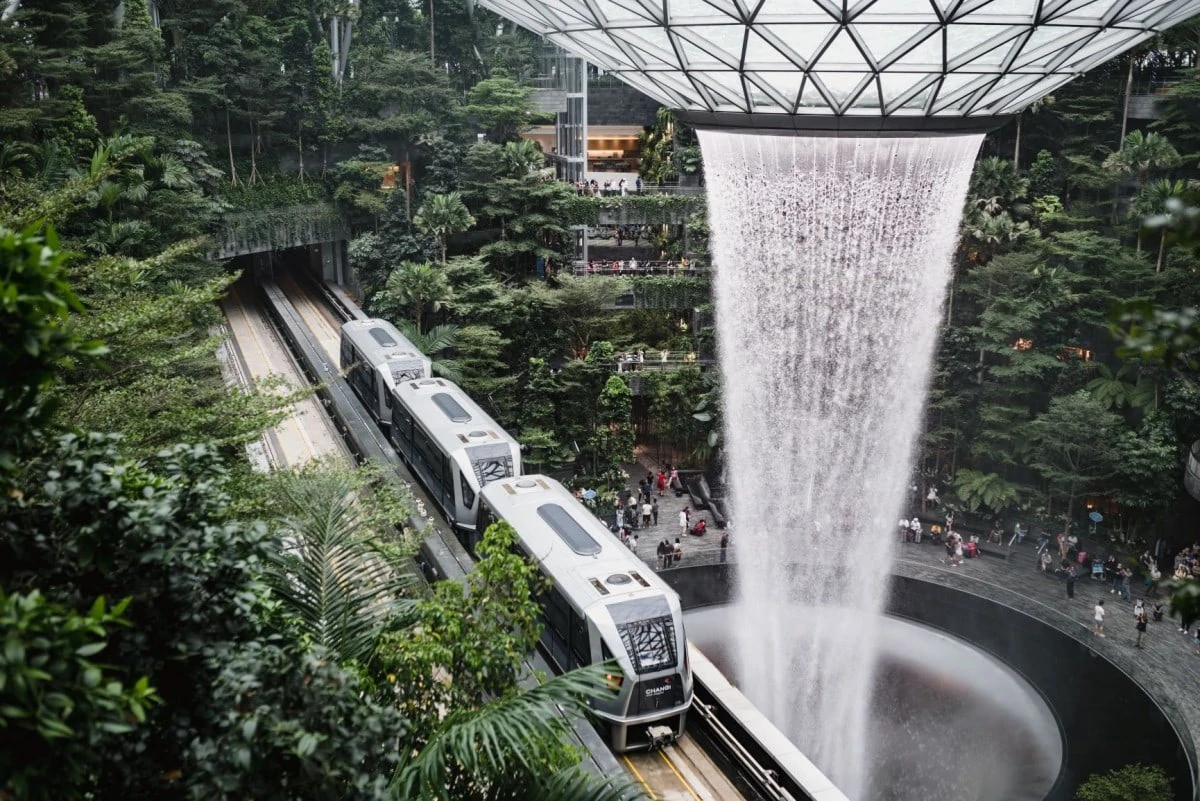
Anyone who thought that the world’s best airport for years would rest on its success, was proven wrong. In 2019, Singapore Changi Airport opened the 1.7 billion Singapore Dollar wing, “Jewel”.
This huge, glass structure is an additional attraction for visitors and locals alike. This iconic new landmark includes an air-conditioned indoor garden paradise, 300 shops and restaurants, and 130 sleeping cabins from Yotelair. And at the centre of this green wonder is the very Instagrammable waterfall – the tallest of its kind at 40 meters.
Another highlight at Changi Airport is Kinetic Rain, a two-part kinetic art installation that has been shown in Terminal 1 at Singapore Airport since July 2012 and extends over an area of 75 square meters. The artwork consists of 1216 copper-coloured drops that are attached to thin steel cables and float up and down over the two escalators in the departure lounge.
However, Changi Airport is not only visually stunning, it also ensures that the departure, layover and arrival is as smooth, uncomplicated and comfortable as possible for travellers. If you land into Changi, you’ll experience the Singapore efficiency, where sometimes you can get from the plane to the taxi in 25 minutes, including entry control, luggage collection and customs clearance.
All of this makes the airport a real icon in Singapore, not just from an architectural perspective.
Think you know your landmarks? Then why not check out these famous landmark quiz questions.
Gardens by the Bay & the Supertree Grove
Explored by Lee from The Travel Scribes
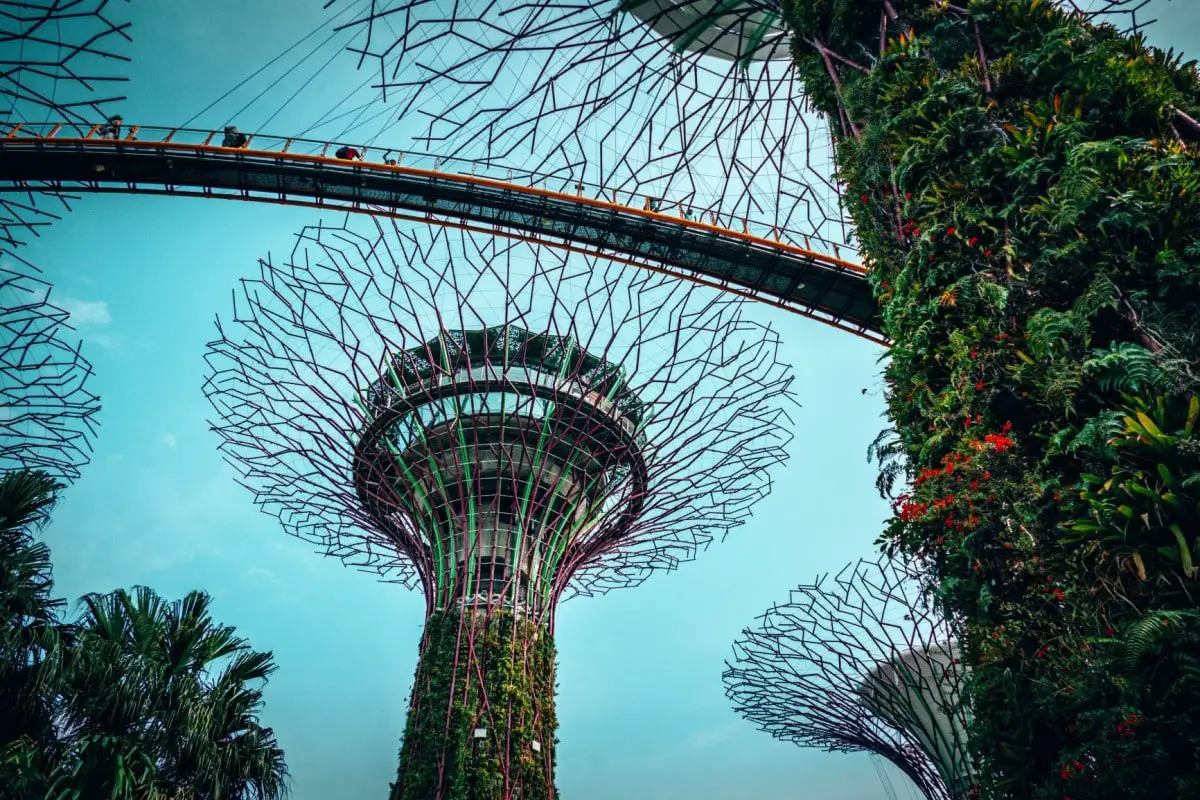
It’s undoubtedly the most famous landmark in all of Singapore: Gardens by the Bay. A nature park extending over 100 hectares, Gardens by the Bay is almost synonymous with Singapore itself: the electric trees of the Supertree Grove a breath-taking feature of the city’s skyline, and the park playing host to tourists and locals alike.
The Gardens is a project run by the nation to create a ‘City in a Garden’, bringing large green spaces and flora to glittering steel structures of Singapore and setting out to improve the air quality in this bustling metropolis. It’s obviously also a tourist mecca, drawing in around 50 million visitors a year.
Constructed as three gardens: the Central, East and South Garden, it’s the last of these that boasts the most attractions. Firstly, the South Garden is home to the Supertree Grove, a soaring ‘forest’ of 18 tree-like installations that reach up to 50 metres off the ground, and are crafted out of reinforced concrete, steel and thousands of planting panels. These trees are an iconic landmark in Singapore and probably what draws many people to the city as part of a Singapore and Malaysia itinerary. The grove also comes to life each evening with a free light show that attracts visitors from afar, making it one of the best things to do in Singapore at night too.
Next up is the Flower Dome, the largest glass greenhouse in the world. As it says on the tin, this is a dome full of gorgeous flowers and floral installations with favourites being the South African Garden, the Baobabs and the Olive Grove. Among the many other gardens is the last large attraction: the Cloud Forest. Set to mimic the cool conditions of the mountains of Asia, you wind your way down the ‘Cloud Mountain’ by way of a circular walkway, taking in the exquisite ferns and orchids adorning all sides of the ‘Mountain’.
A stalwart of popular culture, Gardens by the Bay has been featured in many contemporary films and series, including being the inspiration for the planet of Xandar in Guardians of the Galaxy, a key location for Crazy Rich Asians and chronicled in Planet Earth II. Regardless of your reason for visiting, it’s a must even if you only have one day in Singapore!
Read next: Famous landmarks from around the world!
Helix Bridge
Explored by Jing from Finding Jing
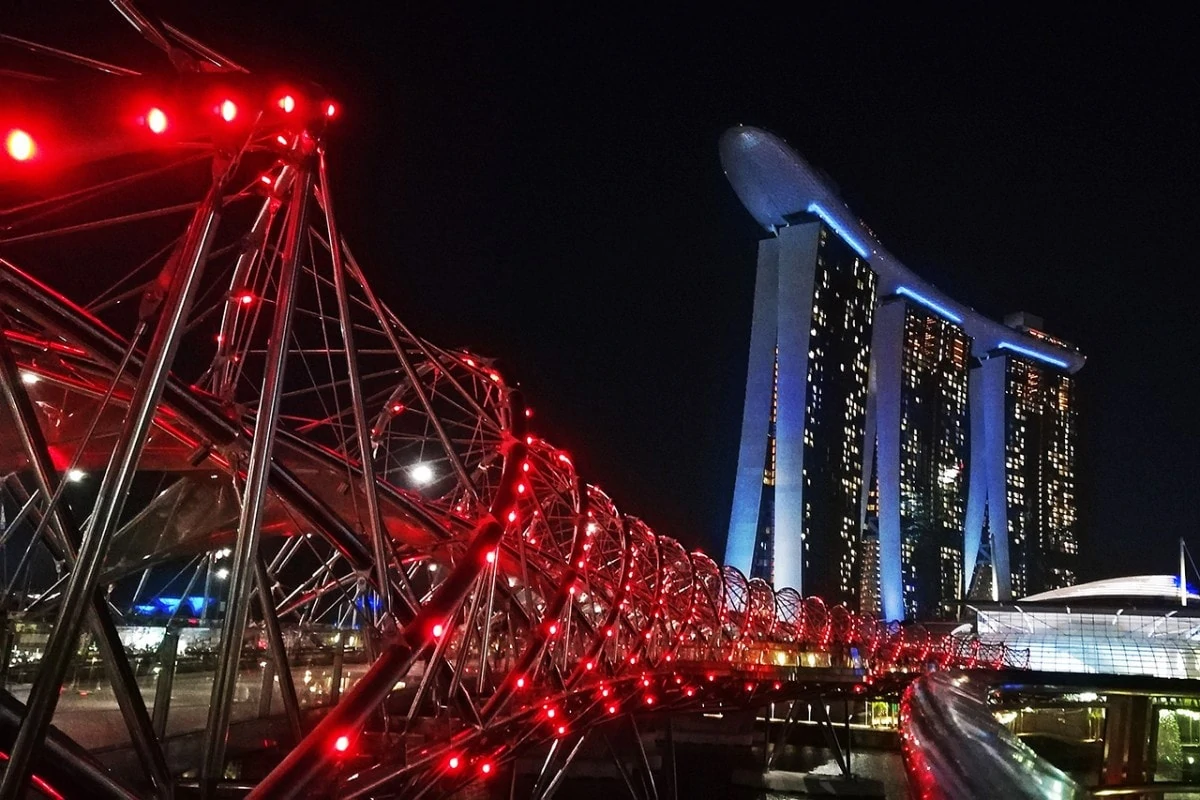
The Helix Bridge is one of the most stunning displays of contemporary architecture in Singapore. The pedestrian bridge, completed in 2010, connects the Bayfront with Marina Center. This visual treat is hard to miss because it loops around other famous landmarks in Singapore – the Marina Bay Sands, Gardens by the Bay and the Singapore Flyer.
The bridge features two opposing spiral steel structures that conjure an image of a DNA, hence its name. The inner helix incorporates canopies that provide shade, allowing pedestrians to use the bridge comfortably even during daytime. However, the best time to walk through the bridge is during the night when the spiral strands gets illuminated with multiple colors.
Along the span of the bridge are four viewing platforms protruding out over the water where you can have amazing views of the colorful Singapore cityscape. The view from the platforms are also popular photography spots for creating images of the lighted spirals leading your eye towards the Marina Bay Sands.
The Helix Bridge is said to be a product of sustainable architecture, using 5 times less steel than conventional designs. Apart from the impressive engineering, for Singaporeans, the Helix Bridge symbolizes life and continuity, renewal and growth.
The Merlion
Explored by Tracy from UK Travel Planning
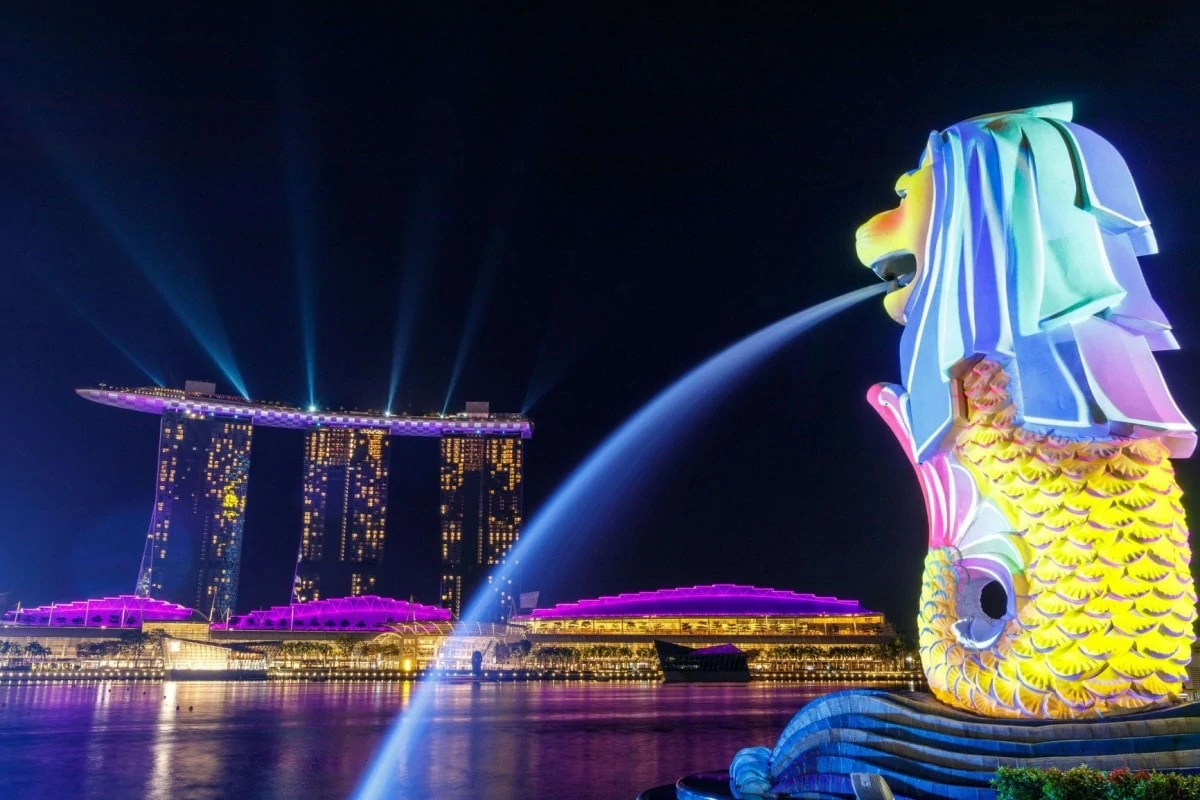
At 8.6 meters tall and standing in front of the Fullerton Hotel the imposing Merlion statue is one of Singapore’s most famous landmarks.
The Merlion with the head of a lion and the body of a fish is the official mascot of Singapore. The fish represents the origins of Singapore as a humble fishing village while the lion represents the ‘lion city’ which it has become today.
The original Merlion statue in Merlion Park at Marina Bay is a popular attraction and was created by sculptor Lim Nang Seng. Don’t miss the smaller Merlion cub which is also in the Park and stands at 2 metres high.
Head to Marina Bay in the evening and enjoy views of the Merlion and the famous water and light show. Look out for the other 5 Merlions that can be found across Singapore!
Related: Ultimate landmarks in Vietnam
Marina Barrage
Explored by Queenie from Ms Travel Solo
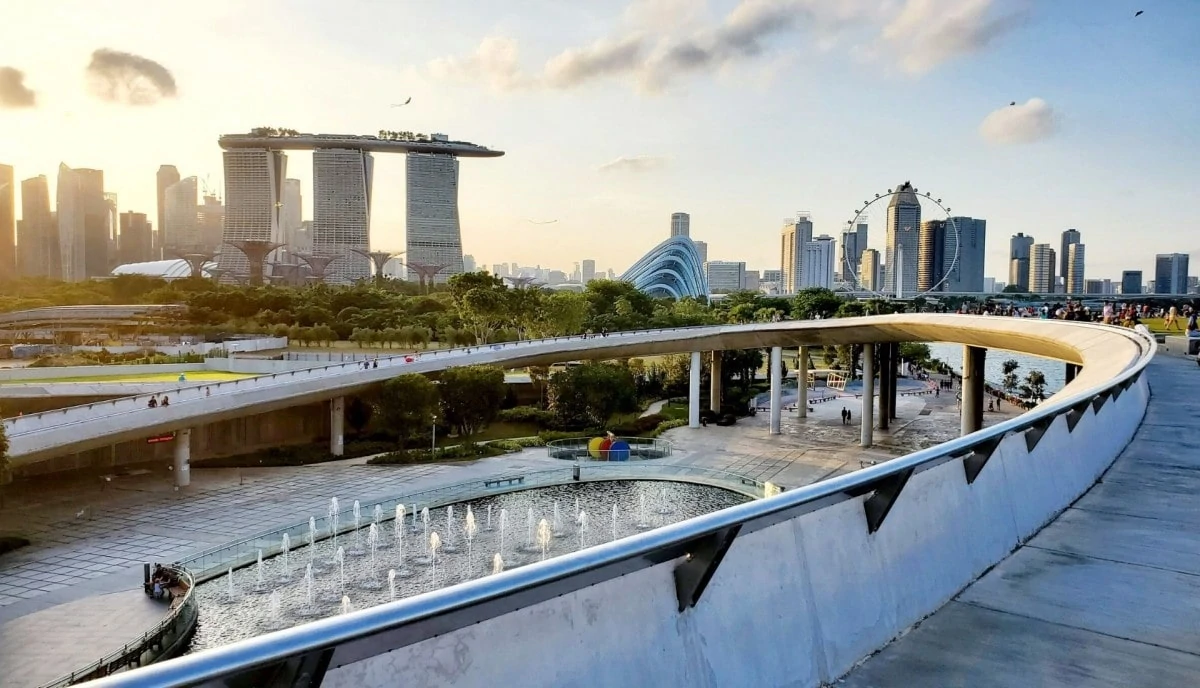
Located at Marina South, Marina Barrage is a source of water supply, alleviates flooding in certain low-lying areas by controlling the dam across the Marina Channel, and is a recreational area for kayaking and dragon boating.
Even though the water reservoir has many functions, the building itself is a major iconic landmark in Singapore. The modern contemporary building is an architectural gem where each design feature is built based on different environmental sustainability principles.
The low-profile building blends seamlessly with the surrounding environment, the continuous green lawn stretches from the ground level all the way to the roof of the building and flows back down again.
The sloping green lawn is a popular spot amongst locals and visitors. Weekends and holidays are full of people flying kites, having picnics and just simply enjoy the outdoors.
And most of all, the view from the green roof is one of the best in Singapore! You can see Singapore’s beautiful skyline including skyscrapers in the downtown area, Marina Bay Sands, Singapore Flyer and other iconic landmarks in Gardens by the Bay.
It is free to visit Marina Barrage. And the best time to visit the water reservoir is around late afternoon or early evening when the temperature is not too hot. Plus, it is the perfect time to catch the sunset. Go early and grab a spot on the lawn and watch the sunset!
Sultan Mosque
Explored by Wendy from The Nomadic Vegan
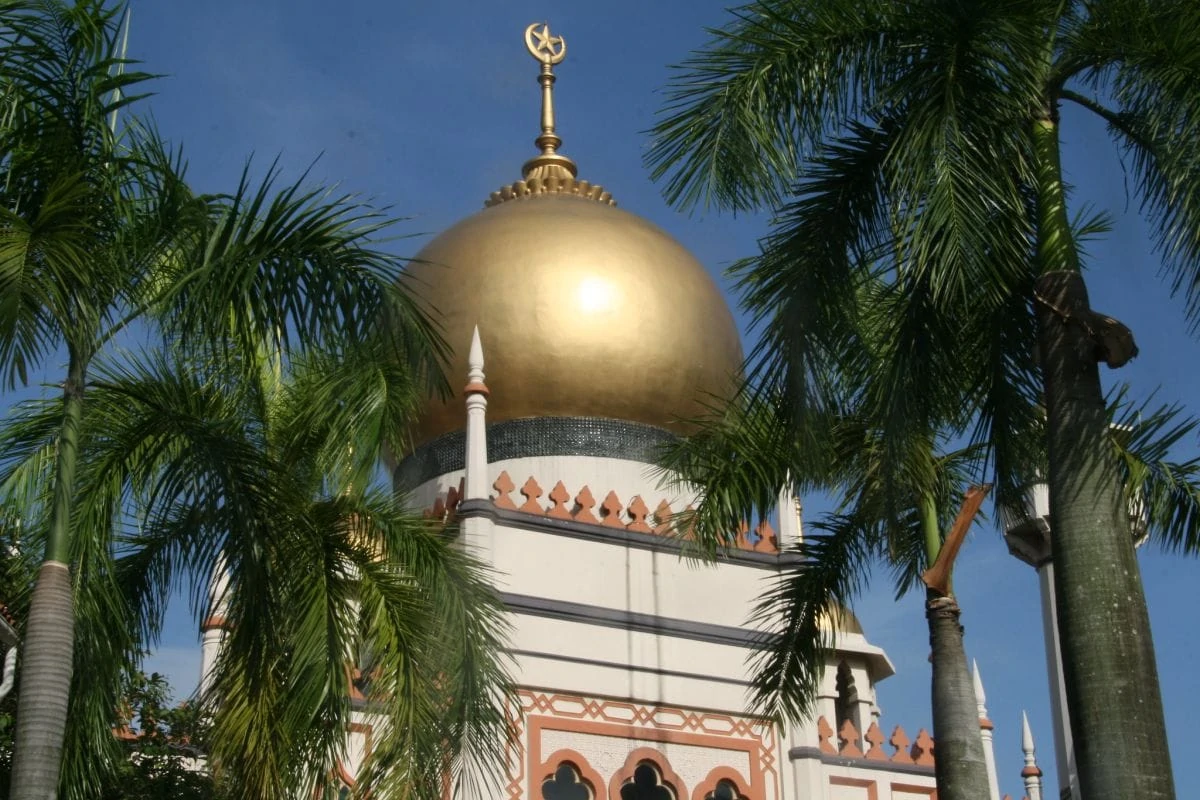
The Sultan Mosque is the largest mosque in Singapore and is considered to be the national mosque. It’s named after Sultan Hussain Shah, who signed two treaties with Britain that culminated in the founding of Singapore as a modern nation-state.
The original version of the Sultan Mosque was built in 1824, but within 100 years it had become too small for the growing community. Thus, in the 1920s the current mosque was built, using materials donated by wealthy and poor Muslims alike. It’s said that the rich people donated gold, which was melted down to cover the gold dome, while the poor donated glass bottles, which were used to decorate the base of the dome. Now the prayer hall can accommodate as many as 5,000 worshippers at one time.
Non-muslims are allowed to visit and can even take photos, but make sure to act and dress respectfully. You will be provided with a robe to wear if the clothes you’re wearing are too revealing.
While you’re in the area, have a wander around the surrounding Muslim Quarter, known as Arab Street. It’s a great place for shopping and for dining at one of the many restaurants serving Middle Eastern cuisine.
Read next: Want to see what landmarks made it on to top US monuments list?
Orchard Road
Explored by Paula from Truly Expat
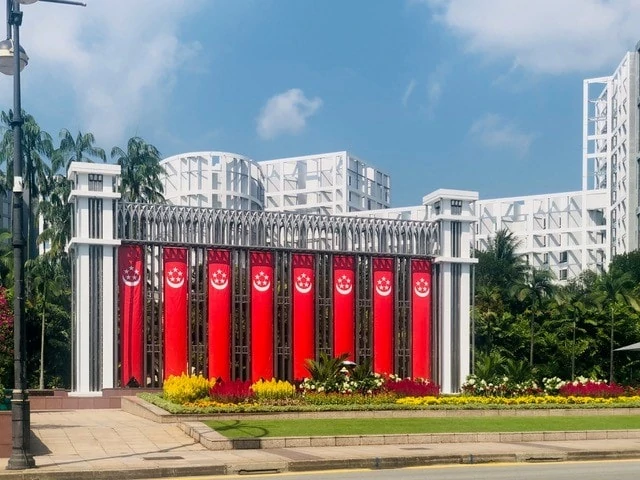
If you are heading to Singapore to shop, well then Orchard Road is where you should start. With more shopping complexes in one location than anywhere else in Singapore, you are bound to find something for everyone. There are many great eateries and bars along Orchard Road and off the many side streets.
Top tip: Emerald Hill Road is an excellent location for an afternoon drink, or you could head to Cuppage Terrace for an outdoor eating experience, with many types of cuisines to choose from there.
Down one end of Orchard Road, you will find the President’s Home (The Istana), where it is open to the public a few times during the year (you must check the website before visiting to see dates). And not far from The Istana you will find the National Museum of Singapore, this is the oldest museum in Singapore, so it is definitely worth a visit.
Located at Orchard Gateway is the Singapore public library, it offers the iconic photo, with the rows of curvy bookshelves, which is one of Singapore’s Instagrammable photo locations! While you are here head downstairs to Orchard Central and find yourself amongst Japanese shops, from restaurants to retail stores, it feels like you have been transported to Tokyo!
If you own an iPhone, pop into the Apple Store and join up to one of the many free photo courses taken around Orchard Rd. The Apple staff know the best locations to take photos in Orchard Road and the photography tips are a great little takeaway.
Related: Instagram Worthy Places in Singapore
Singapore Botanic Gardens
Explored by Stephanie from History Fan Girl
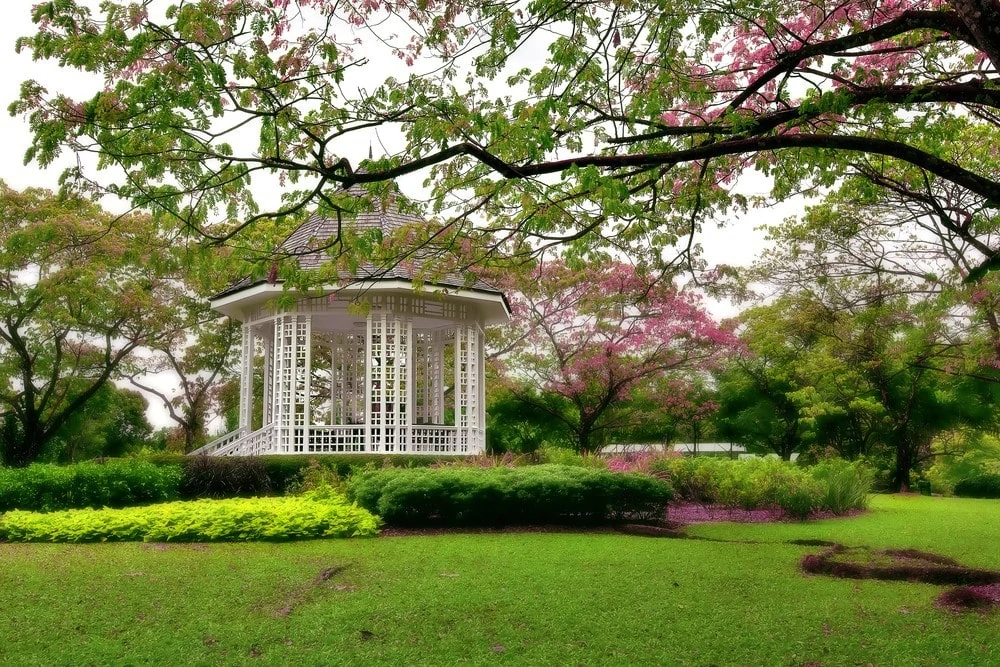
The tiny country of Singapore has only one UNESCO World Heritage Site, but it’s a stunner!
The Singapore Botanic Gardens were first started in 1859, near the beginning of Singapore’s history as a British colony. If you’ve visited England’s Kew Gardens, they will seem quite familiar as they both grew out of the same English botanical garden tradition.
According to UNESCO’s inscription of the site: The Singapore Botanic Gardens is situated at the heart of the city of Singapore and demonstrates the evolution of a British tropical colonial botanic garden from a ‘Pleasure Garden’ in the English Landscape Style, to a colonial Economic Garden with facilities for horticultural and botanical research, to a modern and world-class botanic garden, scientific institution and place of conservation, recreation and education. While the gardens’ historic and scientific importance makes it a great place to visit for cultural reasons, it’s also a fantastic place to stop because they are, simply, just lovely and peaceful.
A few hours walking around the gardens will calm your nerves, relieve stress, and help you enjoy a few quiet moments in an otherwise bustling city. While here, make sure to visit the gorgeous Bandstand that dates back to 1930 and the delicate Swan Lake near the entrance.
You can also learn the history of the gardens at the Heritage Center. If you come hungry, there are many places to grab a bite to eat, and if you’re looking for souvenirs there are plenty of options for shopping.
Henderson Waves
Explored by Ryan from Passions and Places
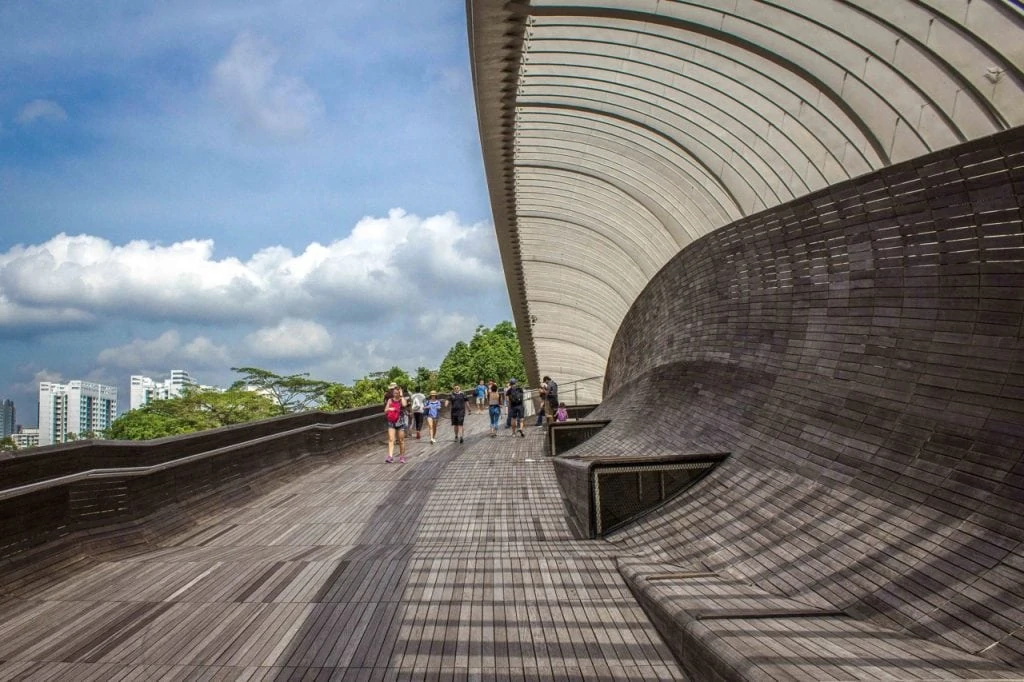
After walking past row after row of skyscrapers, Singapore can start to feel like it’s just a concrete jungle. Fortunately, if you’re looking for actual forests, the city-state also has some fantastic green spaces. One of the finest is the Southern Ridges trail system between Mount Faber and Kent Ridge Park, and at its centre is the charming Henderson Waves pedestrian bridge.
Built a little over ten years ago, the wooden bridge pays homage to the city’s role as one of the world’s busiest ports, utilizing a highly stylized design of undulated lines and a curving canopy. The architecture isn’t just for show, though. Those curves create dozens of nooks and crannies where pedestrians can find shade and a place to rest – a critical feature in Singapore’s sweltering heat. In the evenings, LED lights illuminate the pathway, making it perfect for a romantic stroll.
While the Henderson Waves itself is less than a thousand feet long, the Southern Ridges are nearly ten kilometres from end to end, and the trail passes through some of Singapore’s best natural attractions.
Going on all or part of the hike is a great way to add some movement and time in nature to an otherwise urban vacation.
Related: Iconic landmarks in Myanmar
Esplanade – Theatres by the Bay
Explored by James from The Travel Scribes
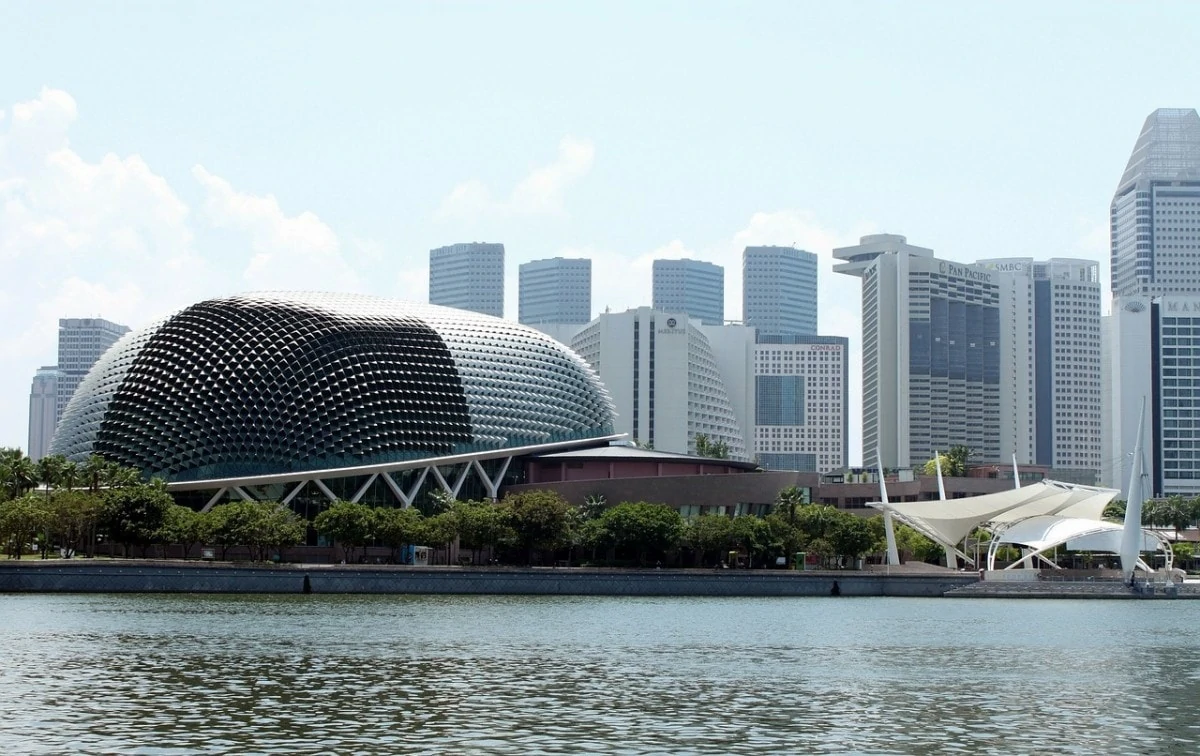
In a city of exquisite and eye-catching buildings, this Esplanade is still one of the best of the bunch. Originally conceptualized back in 1992 as a way to boost the arts in Singapore, the Esplanade took about six years to build, finally opening its doors in 2002.
Named after the park it occupies, Esplanade Park, the Esplanade is two large rounded glass domes covered with over 7,000 triangle-shaped aluminium sunshades. This glittering façade is not only a real attention grabber but has given the building it’s nickname, “the Durian” as locals giggle that its shaped similarly to that spiky, very smelly fruit.
The property is the centre of the arts scene in Singapore, playing host to many a Shakespearean play, ballet performance or music act in its 1, 600 seater Concert Hall or 2,000 seater Theatre.
Sri Mariamman Temple
Explored by Erin from Traveling Thru History
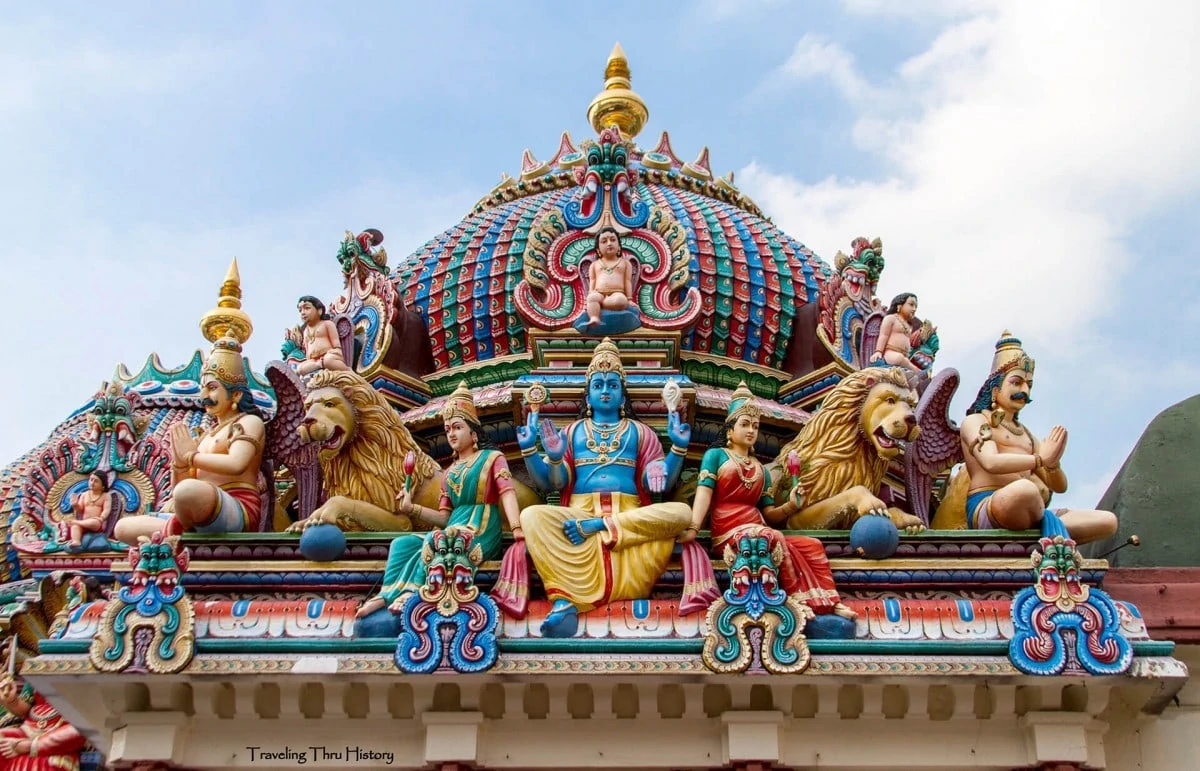
Sri Mariamman Temple is Singapore’s oldest Hindu temple. It was founded in 1827 by Naraina Pillai after several years of trying to find a suitable location. The original temple was built from wood and attap, a type of palm leaf, and included a small statue of the goddess Mariamman, which is where the temple gets its name. Mariamman is a rural South Indian mother goddess who protects against diseases. It wasn’t until 1843 that the temple began being rebuilt from brick.
The most iconic part of the temple, the entrance tower (called a gopuram), was first built in 1903 and then replaced by the current gopuram in 1925, which depicts deities and other important figures from Hindu mythology. In 1973, Sri Mariamman Temple was designated as a national monument.
In addition to the central shrine for Mariamman, the main prayer hall houses additional shrines for Rama, a god of purity and marital devotion; Murugan, a god of wisdom; Durga, a goddess of liberation for the oppressed; Ganesh, a god of intellect and wisdom; and Shiva, a supreme being of Hinduism who creates, protects and transforms the universe. The second main shrine in the temple is dedicated to Draupadi and is central to the annual fire-walking festival, which takes place about a week before the Deepavali festival.
Sentosa Island and Faber Peak
Explored by Anne from Pretraveller
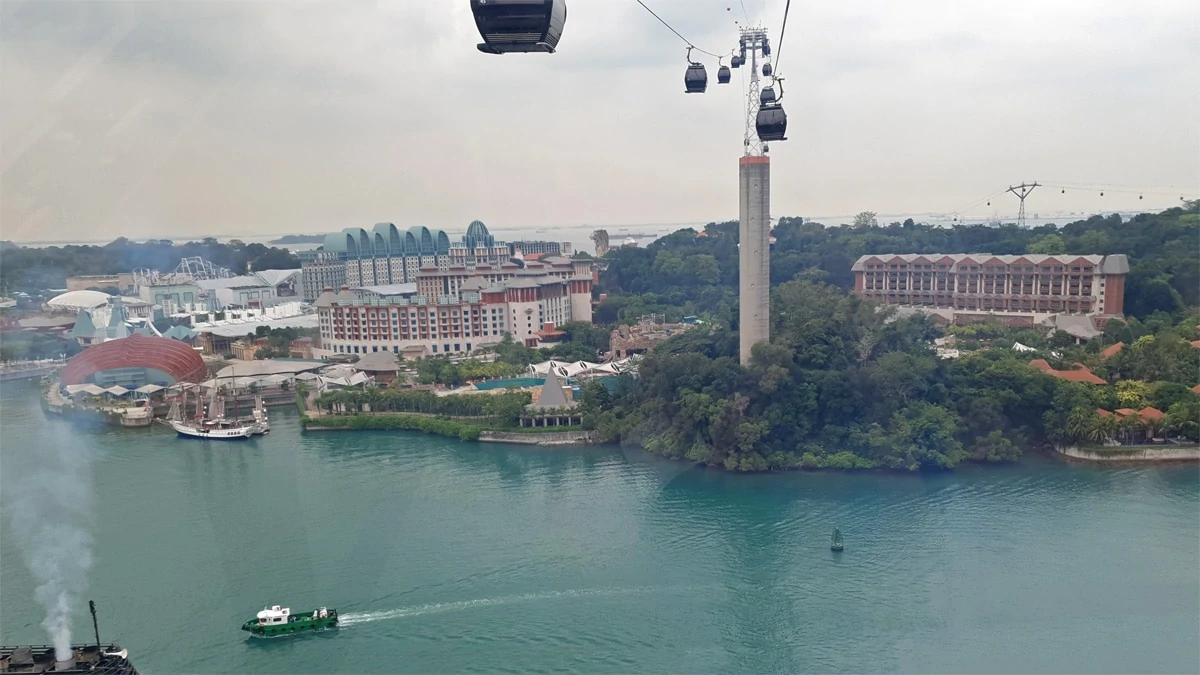
When visiting Singapore a popular destination is Sentosa Island. Separated by Singapore’s main island by the Keppel Harbour, this island used to be a British military base and later housed Japanese prisoners of war before it was turned into a resort.
Nowadays Sentosa is a mecca for tourists, receiving about 20 million visitors a year to it’s many attractions including Universal Studios Singapore, the SEA Life Aquarium and Adventure Cove Waterpark. It also boasts two casinos, fourteen hotels and even two golf courses!
A great way to get to and from the island is by the Singapore Cable Car – which you can board at Faber Peak on the mainland and travels across the water to Sentosa Island. Your ticket for the Cable Car from Singapore to Sentosa will also provide access to the cable car which runs up the middle of Sentosa Island and enabling you to easily get between attractions in the most spectacular way!
Singapore Flyer
Explored by Samantha from Sam Sees World
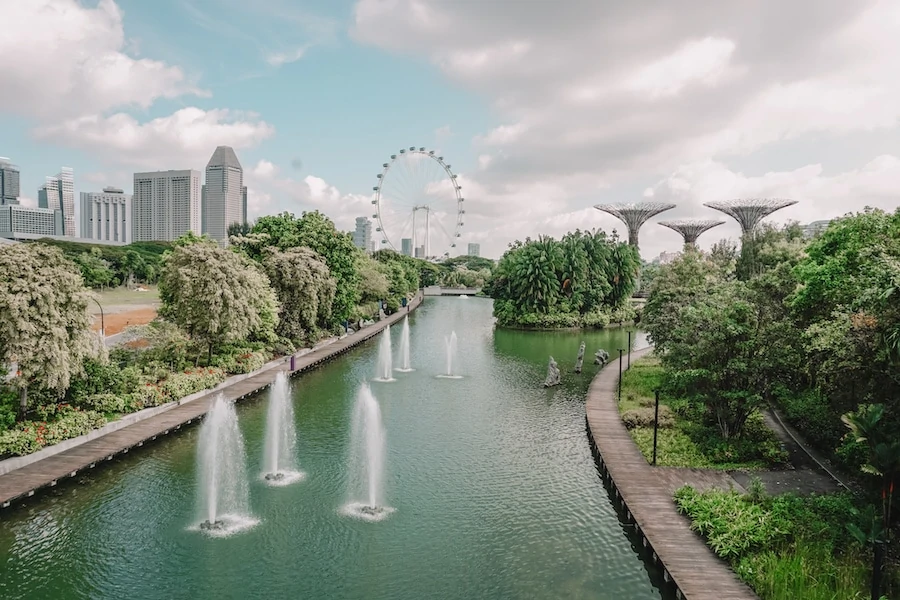
The Singapore Flyer is an iconic part of the Singapore skyline and is not your ordinary attraction. The Flyer stands at a staggering 65 meters above ground and is a landmark you cannot miss. By day the Singapore Flyer stands tall amongst the other buildings. And by night it lights up in an explosion of light, making it pop against the inky black sky.
What’s great about the Singapore Flyer is that it is more than just a landmark, but also an attraction for people to enjoy. It offers spectacular 30-minute rides in the air-conditioned glass capsules that showcase the most stunning views of Singapore’s most iconic sights. From the high vantage point, you get to observe Marina Bay, Raffles, the Singapore River, and much more. On a good, clear day you can even see Changi Airport and other very distant attractions in Singapore.
The magic and surprises of the Flyer do not end there. A night on the Singapore Flyer is one of the best things to do in Singapore for couples due to its enticing and romantic in-flight packages. The packages range from four-course meal dining in the capsules to sipping champagne while riding the flyer and admiring all of Singapore after hours. The Singapore Flyer is a view in itself and offers some of the best views of Singapore.
Related: Iconic landmarks in London
Tan Teng Niah
Explored by Marco from Penang Insider
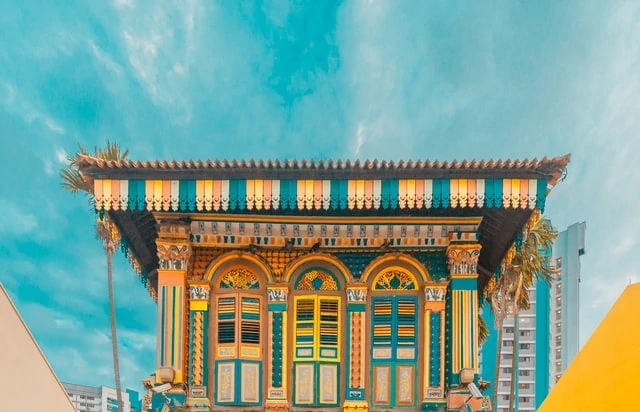
Whether you have one day in Singapore or a whole week, you can’t leave without chasing the multicoloured Chinese shop-house of Tan Teng Niah, one last trace of Chinese heritage in Little India.
Built in 1900 by a Chinese businessman called Tan Teng Niah, this colonial home was near his candy and rubber factories. Like other Straits Chinese tycoons who moved to Singapore to make their fortunes, Mr Tan lived an opulent life in what was the jungle-clad, very different Singapore of way back when.
With the development of Singapore into a technological powerhouse, most of these homes were razed to the ground to make space for skyscrapers and, in the specific case of Tang Teng Niah’s home, the neighbourhood of Little India. The home survived, went through a complete restoration process in the 1980s, and is now preserved by the National Heritage Board under historical landmark status.
More than for its history, the house today is famous for its colours: every gable, roof tile, door and window is painted in a bright tone, and seen from afar, Tan Teng Niah’s house looks like a rainbow. Inside, different tenants have ran diverse businesses, such as a pharmacy and a business training school.
The house is conveniently located just a block away from Little India MRT Station.
Related: Iconic places and famous landmarks in Malaysia
ArtScience Museum
Explored by Darren & Lauren from Faramagan
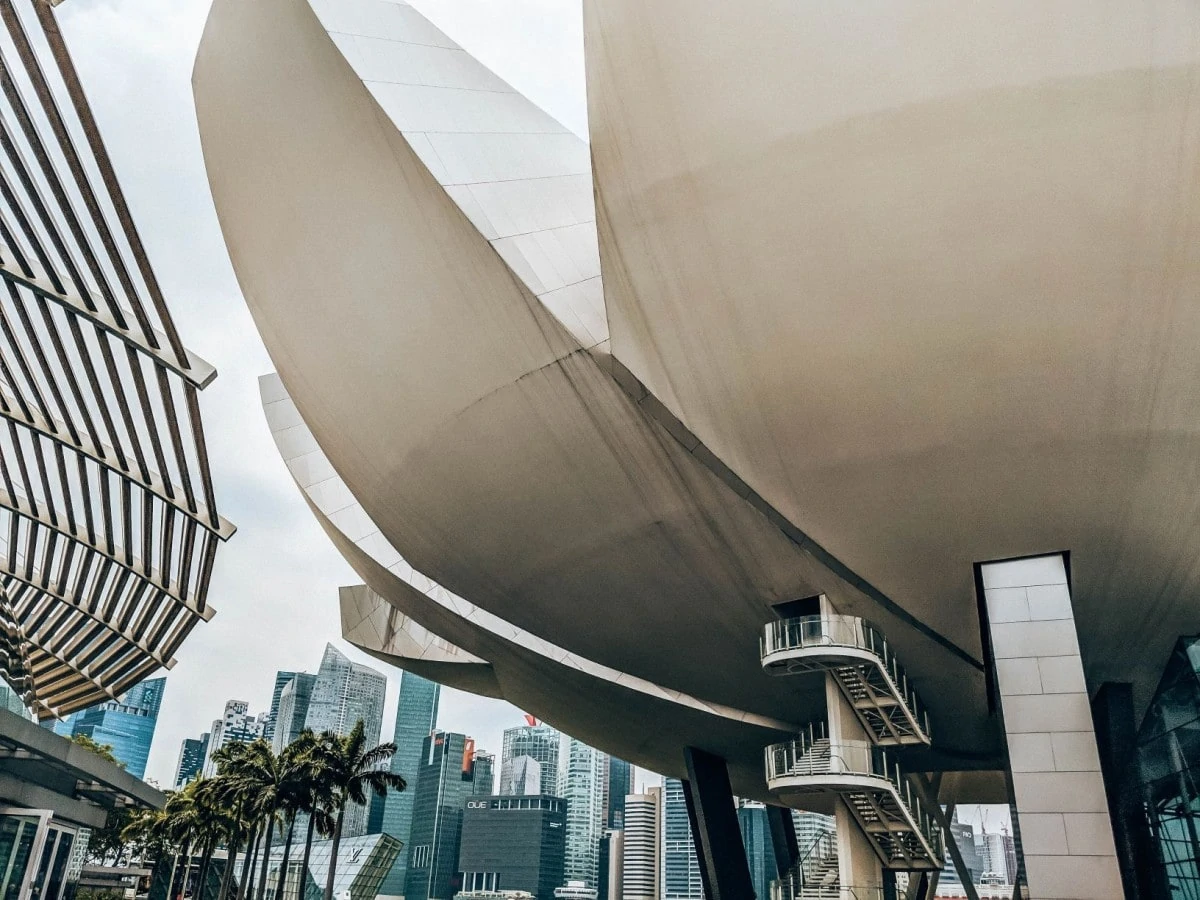
Many people flock to downtown Singapore for the incredible vistas over the harbour, or to admire the towering Marina Bay Sands Hotel. However, there is another icon which is difficult to miss from the Singapore landmark line up – the ArtScience Museum.
This iconic structure is the first of its kind as it is the world’s first ArtScience museum. Like most of Singapore’s architecture, the ArtScience Museum is a futuristic building and thanks to its unique shape – reminiscent of a lotus flower – it is a prominent feature in the Marina Bay Sands complex. Don’t just admire it from the outside, however, as once inside, you will be equally amazed thanks to over 6,000 square meters ready to be explored, photographed and enjoyed thanks to the 21 interactive spaces.
Since opening in 2011, it has welcomed tourists from all over the globe to the magical realm of science and art. Thanks to the geniuses at TeamLab there is a permanent exhibition known as “Future World” which offers all ages to interact with themes such as nature, technology, sustainability and space. As well as the striking exhibitions, the building itself is a work of science. All water in the museum’s restrooms is from recycled rainwater, collected via the unique bowl-shaped roof.
A visit to the ArtScience Museum (whether admiring from inside or out) will be a highlight of any Singapore itinerary and a landmark you will never forget!
Related: Landmarks in Indonesia
The Kranji War Memorial
Explored by Sarah from Let’s Grow Cook
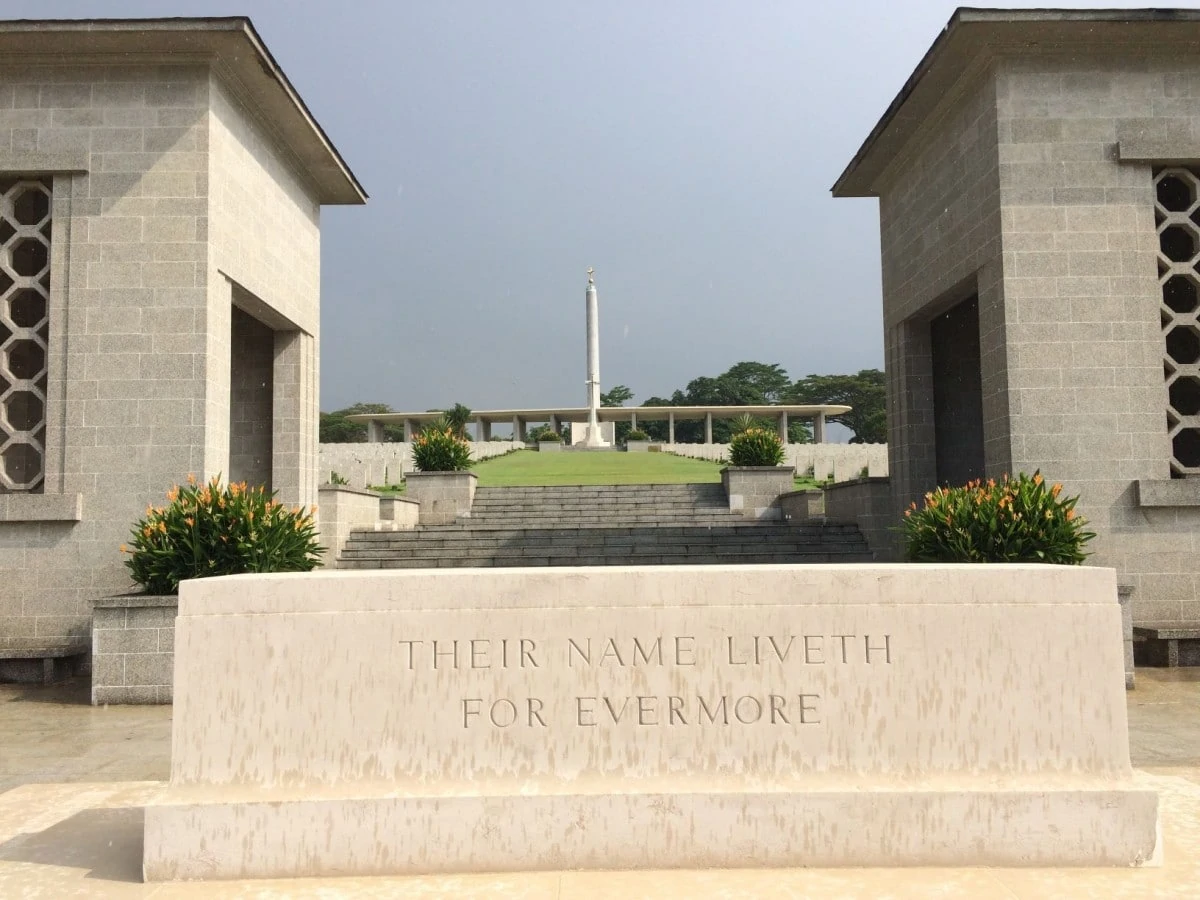
During World War II Singapore was considered impregnable and so the fall of the island state to the Japanese on 15th February 1942 was considered a huge shock. Of the buildings relating to the war in Singapore, the Kranji War Memorial is perhaps the most poignant. This location has been a munitions depot, a prisoner of war camp and then a burial ground. The memorial and cemetery here are for those who died defending Singapore.
The design of the memorial is extremely symbolic. It represents the three branches of the military – the Army, the Air Force and the Navy. The columns are for the Army, which marched in columns. The cover is shaped like the wing of a plane and the top resembles the sail of a submarine. There are 12 columns, on which are inscribed the names of the 24,000 men whose bodies were never found.
The Kranji War Memorial is located in Northern Singapore, just 4 kilometres from where the Japanese crossed the Johor Strait to invade the island. The site is maintained by the Commonwealth Graves Commission and while it isn’t on many visitors lists of places to visit, it tells an important part of Singaporean history.
The Raffles Hotel
Explored by Elisa from World in Paris
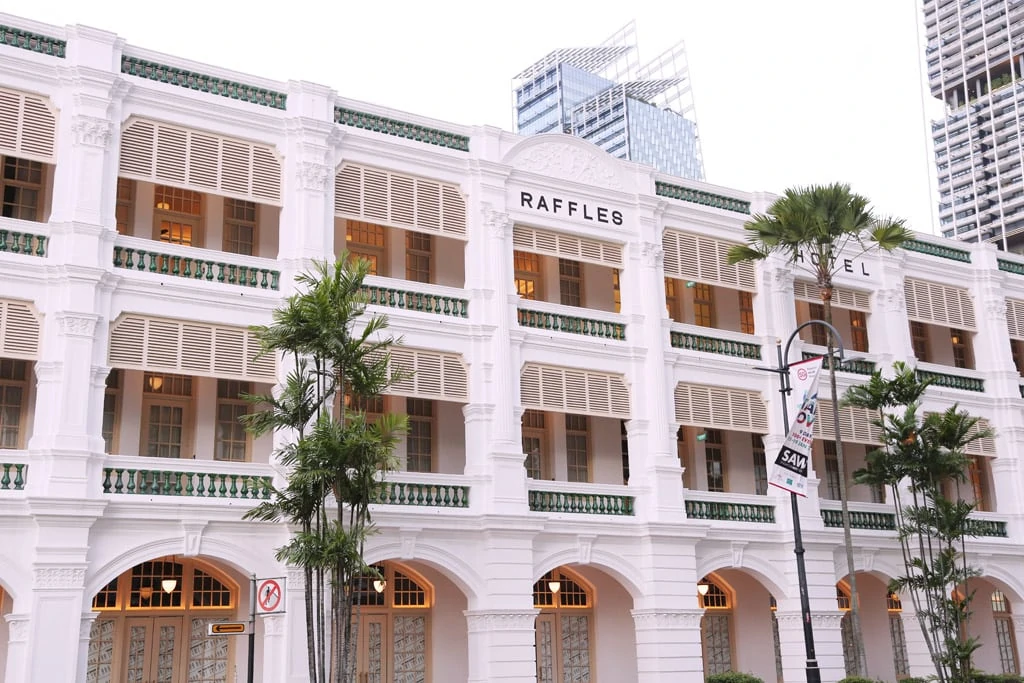
One of the must-sees when visiting Singapore is the Raffles Hotel, a luxury hotel built in colonial-English style in 1887. The hotel was owned by two Armenian brothers, but it was named after Sir Thomas Stanford Raffles, the founder of modern Singapore. Today, the Raffles Hotel is listed as a National Monument of Singapore.
Not all the people have the budget to stay at the Raffles Hotel but it is a beautiful place to see. On the side-facade there are a couple of access points that are always open, so it is possible to get a look at the inner courtyard and access the outdoor restaurant and terrace. It’s a great way to get a glimpse of life at Raffles.
In addition, Raffles is famous for its bar. It was in this bar on the first floor where the famous cocktail Singapore Sling was born! The Singapore Sling is a gin-based drink created in 1915 by one of the bartenders of the Hotel Raffles.
Today, the Singapore Sling is so famous that it is one of the cocktails selected by the IBA (International Bartenders Association) for use in the annual World Cocktail Competition. The Raffles bar is opened also to non-guests so you cannot miss the opportunity of tasting this unique cocktail in such an iconic place.
Clarke Quay
Explored by Maureen from So Many Places! So Little Time!
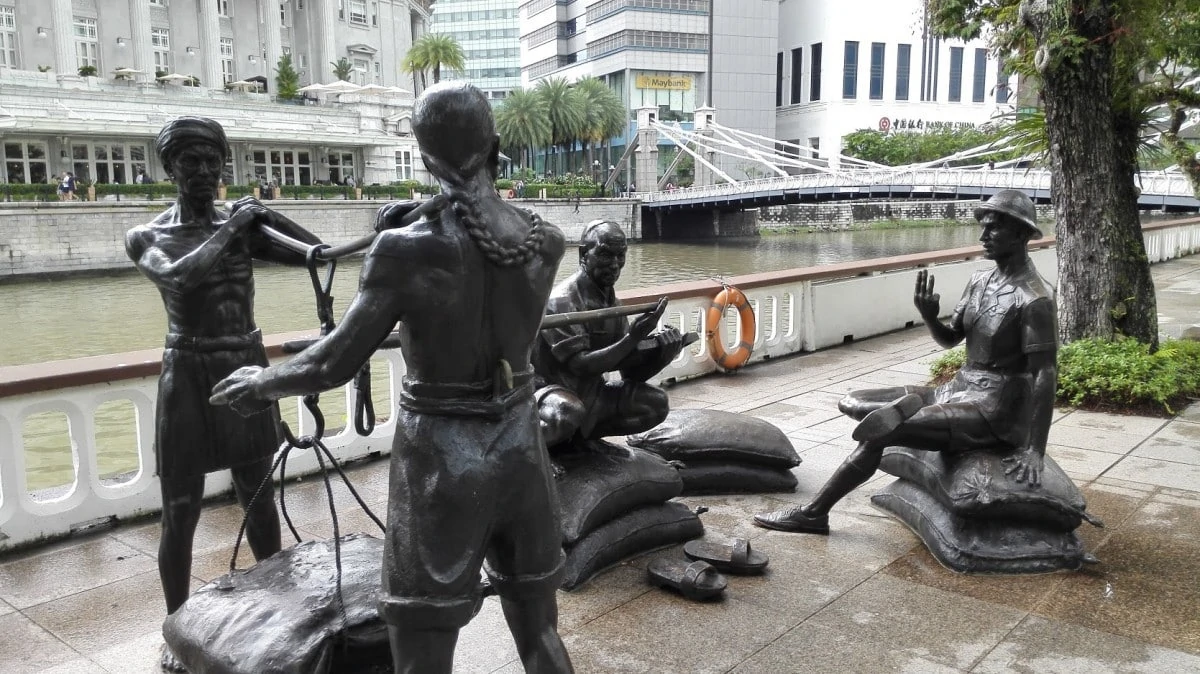
Clarke Quay is a must-see landmark when you’re visiting Singapore. It’s a vibrant, historical waterfront area just north of Chinatown and set on the Singapore river. The Quay is lined with colourful shophouses and colonial-era architecture. Clarke Quay is best known for its nightlife, but it’s also a really pleasant and interesting place to visit in the daytime.
At night the area comes alive with its colourful bars, restaurants, and shops with lots of lights, music, and action. You might want to check out some of the popular nightclubs like Attica, Zouk, and F-Club. You will have a wide selection of restaurants to choose from, and for something a little different, you might want to dine at one of the floating restaurants converted from traditional Chinese junks. The G-Max Reverse Bungy ride which falls 80 meters at speeds of up to 120mph is great if you need an adrenalin rush!
A river cruise from Clarke Quay will give you excellent views of the surrounding area and stunning skyscrapers and take you past Boat Quay, Robertson Quay, and several major landmarks including the Marina Bay Merlion and the magnificent Marina Bay Sands.
There are plenty of interesting places to see in the daytime. We loved the People of the River sculptures (see below) which we found while house sitting in Singapore. They are near Fullerton Square and depict various trade activities that took place in the 19th century around the Singapore River.
Wander through Fort Canning Park, which has some interesting graves from the colonial era and colourful gardens. The Asian Civilisation Museum and the very colourful Old Hill Police Station are nearby too.
Related: Iconic places and landmarks in Thailand
The colourful shophouses of Joo Chiat
Explored by James from Where You’re Between
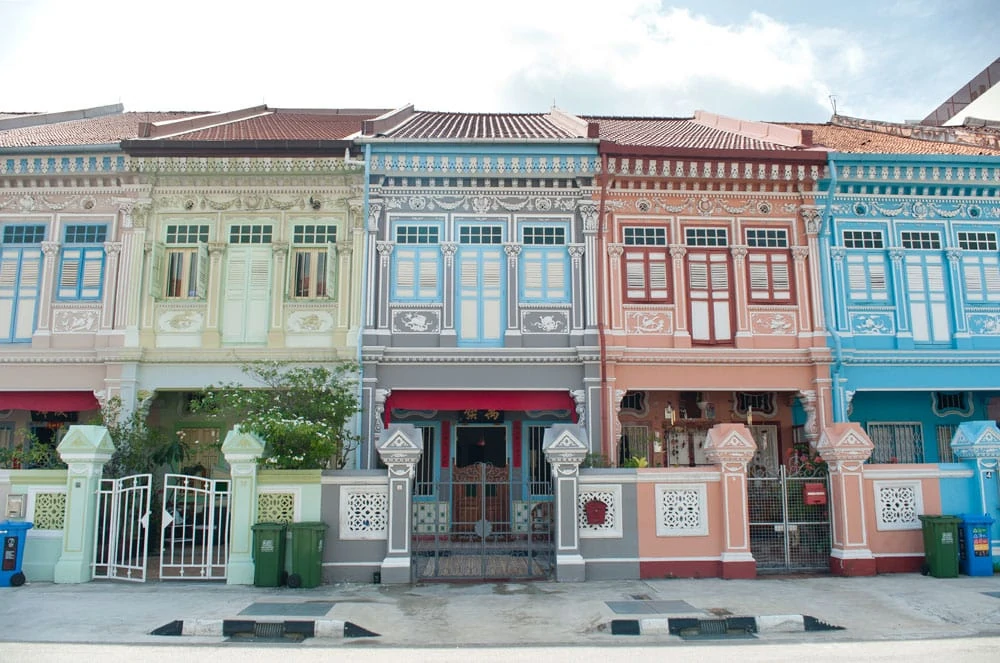
The traditional Peranakan shophouses along Koon Seng Road in Joo Chiat are some of the most instantly recognisable landmarks in Singapore. Decorated in a rainbow of colours, these gorgeous terraced shophouses are perhaps Singapore’s most beautiful heritage homes.
The shophouses on Koon Seng Road were built in the 1920s and 1930s by wealthy merchant traders. Designed in a typically flamboyant Peranakan style that is common in Singapore and parts of Malaysia, the spectacular shophouses have naturally become a mecca for Instagrammers.
The multi-coloured shophouses are painted in a dazzling array of pinks, blues, oranges and greens. In addition to the spell-binding colours, the houses’ facades are also embellished with traditionally ornate Peranakan tiles.
Resembling a luxuriously elaborate wedding cake, the shophouses’ magnificent designs are rounded off with beautifully crafted columns and Rococo-inspired architectural details. Keep an eye out for the decorative flowers, birds and mythical beasts that add even more character to each house.
Koon Seng Road is just a short trip to the east of the centre of Singapore. The nearest MRT station is Paya Lebar, which is around a fifteen minute walk away. If you’d rather not walk that long in Singapore’s unforgiving heat and humidity, take the MRT to Kallang and then jump on the 33 bus from outside the station. This will drop you off just a few hundred yards from the shophouses.
Read next: The 15 most iconic landmarks in Sri Lanka
Buddha Tooth Relic Temple
Explored by Mal from Raw Mal Roams
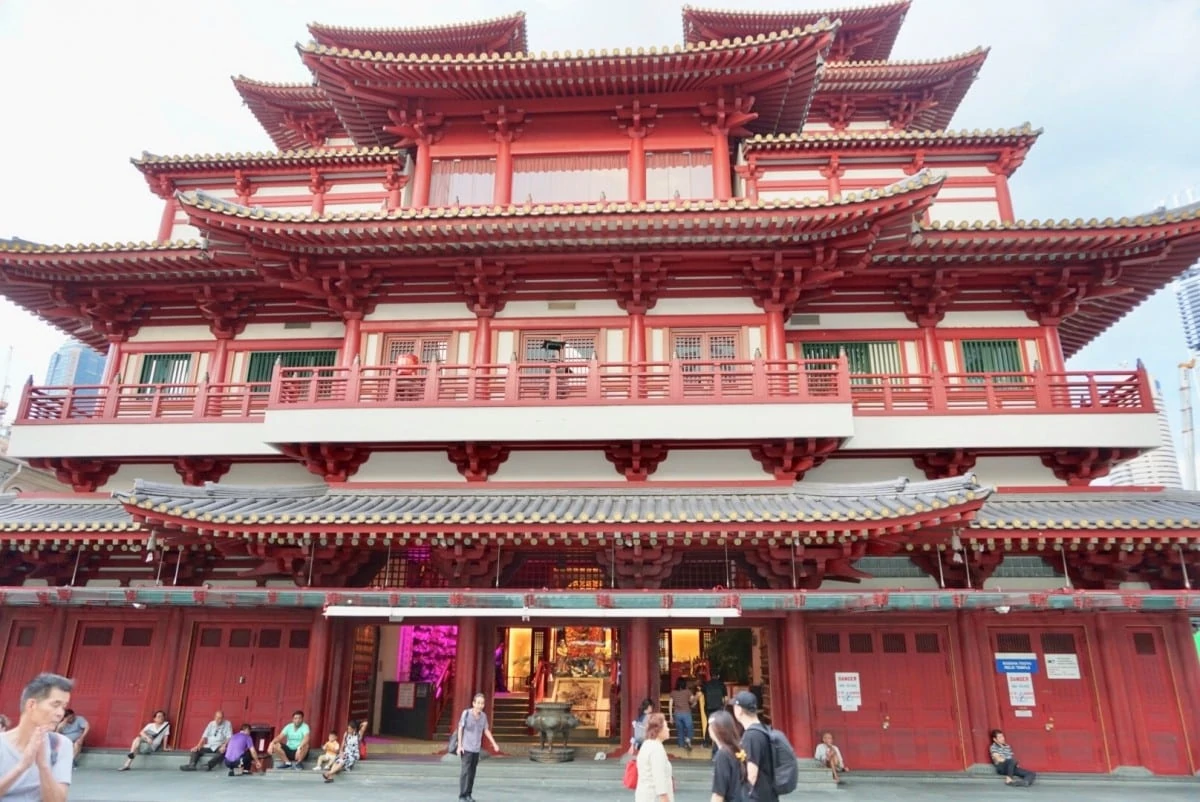
Buddha Tooth Relic Temple is located in the heart of Chinatown. This astonishing Buddhist temple was built in 2007 and takes its name from the tooth of Buddha that was recovered from his funeral in India, and now it’s displayed in the temple.
The temple was built based on Tang Dynasty architecture, and it is the most beautiful landmark in Chinatown with its red façade and green window shutters plus a 3,500 kilogram giant stupa that was made of 320 kilograms of gold! There is also a museum that holds various Buddhist artefacts and a theatre where various performances take place. Don’t forget to explore the roof garden, which is a tranquil place to relax and take a break. The whole temple is fully air-conditioned and beautifully ornated.
There are two entrances, one gives access to all five floors and the second one allows access only to the ground floor. There is an elevator to the other levels.
The entrance is free of charge and every Saturday, there is a free, 2-hour tour of the whole temple grounds in English conducted by temple volunteers. Wear respectful attire, covering your knees and shoulders, and no hats are allowed. There are shawls to borrow at the entrance for women to cover up.
Related: Iconic landmarks in China
Marina Bay Sands
Explored by James from The Travel Scribes
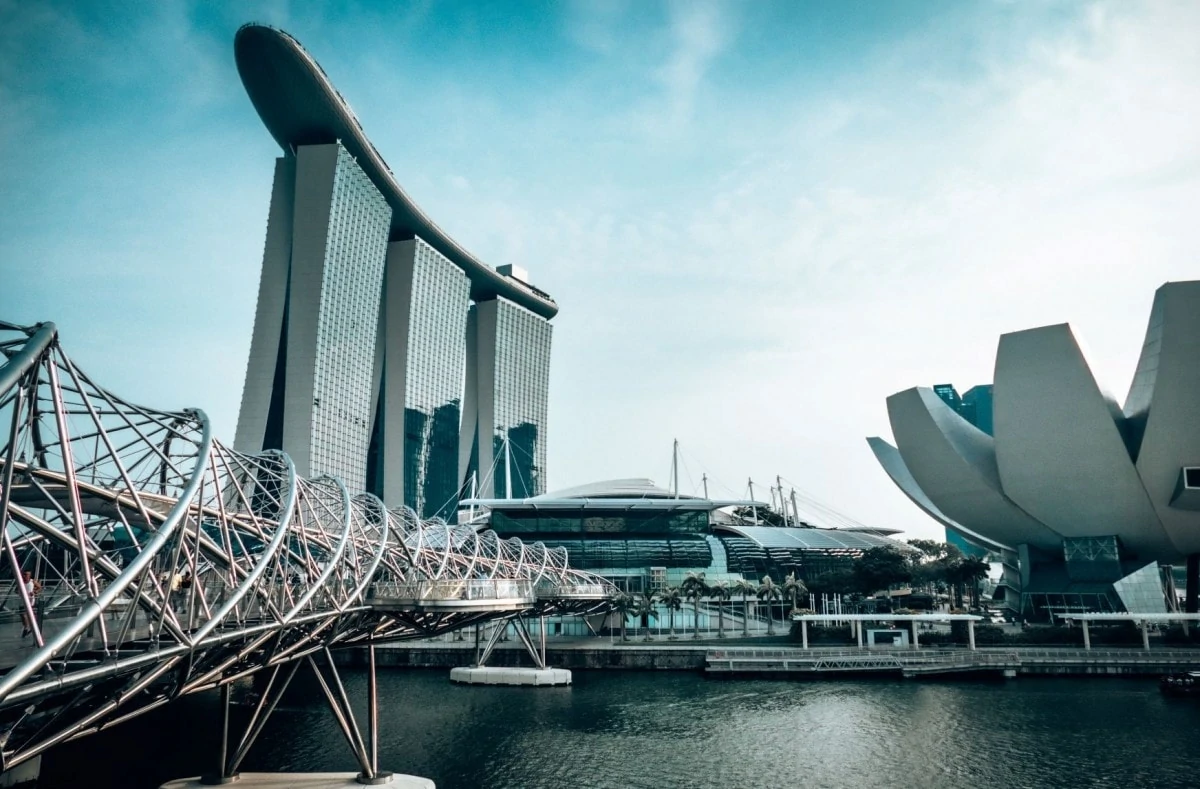
Vying with Raffles Hotel for the most iconic hotel in Singapore, there is no doubt that the Marina Bay Sands dominates the skyline in Singapore. Inspired by playing card decks, this prominent hotel has three soaring towers, with an almost lintel-like structure lying atop them.
First opened in 2010, Marina Bay Sands is more than a hotel (of which it has over 2, 500 rooms) but boasts a huge 120, 000 square metre convention centre, a bustling 74, 00 square metre shopping mall (The Shoppes at Marina Bay Sands), myriads of restaurants, exhibitions and an indoor skating rink! All of these features were opened in stages since the owner, Las Vegas Sands, ran into a few money troubles during the construction and so had to phase the building of this enormous complex.
Not to be outdone in terms of world records, it has the globe’s largest atrium casino, with over 1,600 slot machines set up for avid gamblers; as well as the world’s largest rooftop infinity pool. Perfect for a quick dip and, of course, taking a few very Instagrammable shots of the city.
There’s chatter that the complex will open a fourth tower in the future, making this legendary Singapore landmark an even more prominent feature in the city-nation.
Landmarks in Singapore interactive map
So, what do you think of our top 10 Singapore Landmarks and the others that made it onto our ultimate list of 21 iconic buildings and famous landmarks in Singapore? Let us know in the comments below if you think that we’ve missed any off!
Want to save this for later? Why not pin it…
